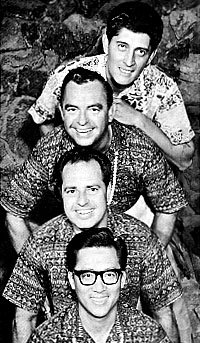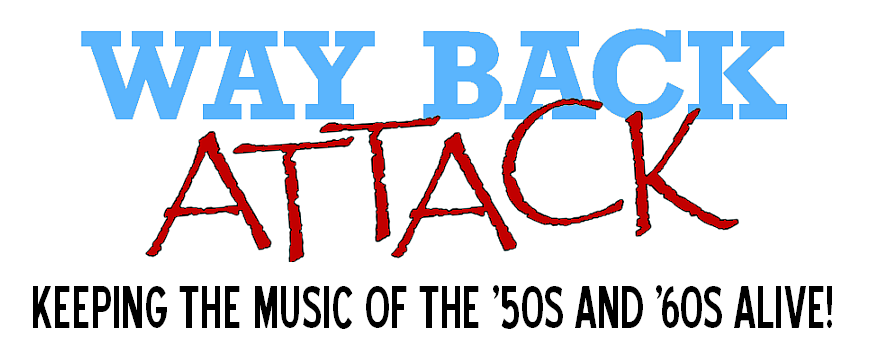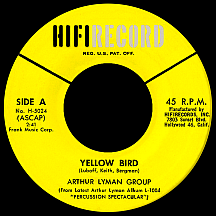ARTHUR LYMAN GROUP
Yellow Bird
The "exotica" craze of the 1950s got under way in the decade's first year with Peruvian "princess" Yma Sumac's Voice of the Xtabay, the surprise hit album largely responsible for popularizing so-called "jungle rhythms." Within a few years, interest had spread from South America to various Pacific and Caribbean islands. Calypso music became the rage when Harry Belafonte reached a seemingly unlimited audience and instrumental acts like Les Baxter and Esquivel combined folk songs of the tiki-lounge technique with an Americanized pulsation. Arthur Lyman was among the few actual Pacific-dwelling musicians to achieve major mainland success; his setting was a bit more authentic and he became one of the genre's two artists to score top ten hits; residents of the U.S. territory of Hawaii, both were, at one point, members of the same band.
New York native Martin Denny established himself as a pianist and had worked with a number of bands since the 1930s. Following a 1954 engagement in Honolulu, he decided to stick around and form his own island-based outfit. The 22-year-old, Kauai-born Lyman, who'd started out practicing a toy marimba as a toddler, joined the 43-year-old Denny's new group in the role of vibraphonist (he'd been playing the instrument professionally with a local group, The Gadabouts, since high school). Lyman developed a unique way of performing with four mallets, a technique considerably trickier than using the standard two (though later, some show-offs took to playing six...or even eight!).
Baxter, who'd conducted the orchestra (and used his given first name, Leslie) on Sumac's debut and his own 1951 LP Ritual of the Savage, had considerable success in 1956 with Tamboo!, a Hollywoodish take on the as-yet-unnamed exotica approach. Denny's group, meanwhile, lit up the stage regularly at the Shell Bar on Waikiki Beach, part of the Hawaiian Village Hotel owned by Henry J. Kaiser (the aluminum and Permanente guy). Lyman had left Denny by that time to take a spin at stardom leading his own fun-loving foursome. Native Oahuans John Kramer (bass, ukulele, guitar, flute, clarinet), Allan Soares (piano, celeste, guitar) and Harold Chang (xylophone, percussion...technically they were all percussionists!) combined for a sound not unlike (and in many ways identical to) Denny's; Leis of Jazz was Lyman's first album on Richard Vaughan's Los Angeles-based HiFi label.
Taboo, Lyman's breakthrough 1958 longplay, was not so forbidding as its title (though suspiciously close in spelling to Baxter's earlier effort). It spent much of the spring, summer and fall in the "stereo albums" top ten, beating former cohort Denny to the punch. Then in the spring of 1959, Denny's Exotica album rose to number one (and supplied the trend with its name); his million-selling single "Quiet Village" hit soon after...and not long after that, a single edit of Lyman's "Taboo" title track was a mid-charting hit, more than a year after the LP debuted. Sound effects, recreated by a variety of unusual instruments (Chinese gongs, wood blocks and the occasional strangely-carved object), were plentiful in both artists' work - bird calls sometimes came from real birds! The two colleagues were suddenly rivals, albeit friendly ones; after all, the timing was good for both. Strong record sales and high-profile demand from tourists happened right about the time Hawaii officially became the nation's 50th state.

Arthur Lyman was locked in - he averaged three albums per year for HiFi over the next decade (sometimes the billing was solo, other times it went to the Arthur Lyman Group). His albums were usually recorded near the hotel at Kaiser's Aluminum Dome (described as a half-sphere, it seated 1500 people and doubled as a recording studio). His biggest hit came in 1961 with "Yellow Bird," which had originated as a poem, Choucoune, written by Haitian Oswald Durand in 1883. Ten years later it was set to music by Durand's countryman Michel Mauléart Monton. The lyrics were rewritten in the 1950s as two songs: "Don't Ever Love Me," with lyrics by Harry Belafonte, who recorded it in 1957, and "Yellow Bird" ('...up high in banana tree'), the more popular version credited to songwriters Norman Luboff and Marilyn and Alan Bergman, which had been a minor hit for The Mills Brothers in 1959. Lyman's easy island instrumental made the top ten in July '61, during a peak time for instrumentals (13 reached the top ten that year).
"Yellow Bird" led to a featured spot on ABC-TV's Hawaiian Eye (which starred another top 40 music act, Connie Stevens); between December '61 and June '62 during the series' third season, Arthur and his band appeared ten times, performing on a set built to replicate the Shell Bar. Another single made an impact in the early months of 1963; Cole Porter's classic "Love For Sale" (from the 1930 Broadway musical The New Yorkers) had been a hit in '31 for Libby Holman, perhaps the most scandalous, rough-around-the-edges singer of that era (the press nicknamed her "The Dark Purple Menace"). Even the lyrics were suggestive ('Who's prepared to pay the price for a trip to paradise?')...but who would'a thunk it in the '60s if all they'd ever heard was Arthur Lyman's jazzier-than-usual humdinger of an instrumental?
Fortune smiled on the quadruple-mallet Mr. Lyman; he found his niche early and became a big star right at home on the beaches of Hawaii, beating Don Ho, the next big Waikiki club entertainer, into the spotlight by several years. In the 1990s, during the resurgence of "exotica," "lounge music," "space age pop" or whatever you choose to call it, Arthur Lyman enjoyed renewed popularity. He continued performing right up until his death in 2002. Even his old pal Martin Denny was there to help look after him near the end.


